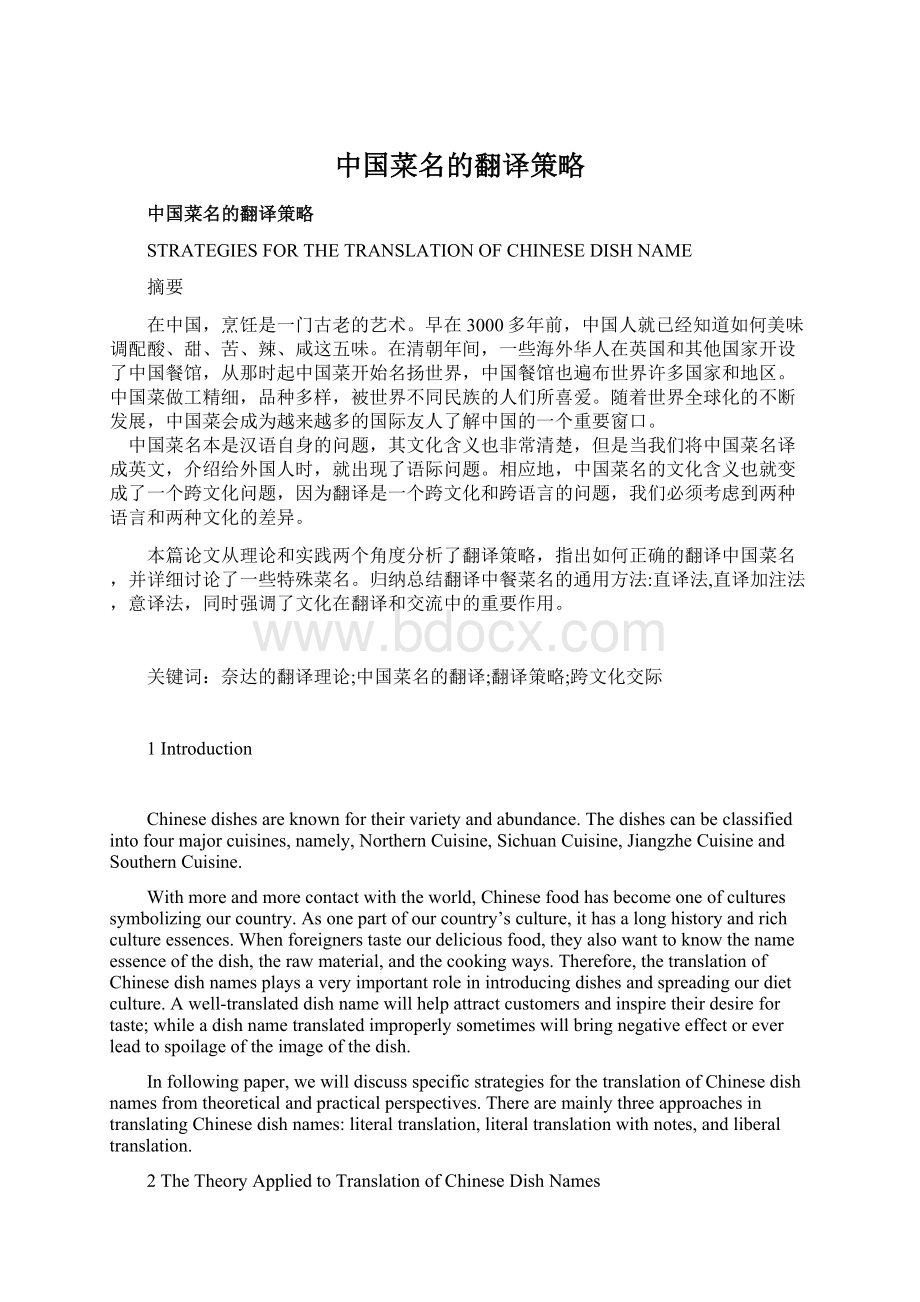中国菜名的翻译策略Word格式文档下载.docx
《中国菜名的翻译策略Word格式文档下载.docx》由会员分享,可在线阅读,更多相关《中国菜名的翻译策略Word格式文档下载.docx(10页珍藏版)》请在冰豆网上搜索。

中国菜名本是汉语自身的问题,其文化含义也非常清楚,但是当我们将中国菜名译成英文,介绍给外国人时,就出现了语际问题。
相应地,中国菜名的文化含义也就变成了一个跨文化问题,因为翻译是一个跨文化和跨语言的问题,我们必须考虑到两种语言和两种文化的差异。
本篇论文从理论和实践两个角度分析了翻译策略,指出如何正确的翻译中国菜名,并详细讨论了一些特殊菜名。
归纳总结翻译中餐菜名的通用方法:
直译法,直译加注法,意译法,同时强调了文化在翻译和交流中的重要作用。
关键词:
奈达的翻译理论;
中国菜名的翻译;
翻译策略;
跨文化交际
1Introduction
Chinesedishesareknownfortheirvarietyandabundance.Thedishescanbeclassifiedintofourmajorcuisines,namely,NorthernCuisine,SichuanCuisine,JiangzheCuisineandSouthernCuisine.
Withmoreandmorecontactwiththeworld,Chinesefoodhasbecomeoneofculturessymbolizingourcountry.Asonepartofourcountry’sculture,ithasalonghistoryandrichcultureessences.Whenforeignerstasteourdeliciousfood,theyalsowanttoknowthenameessenceofthedish,therawmaterial,andthecookingways.Therefore,thetranslationofChinesedishnamesplaysaveryimportantroleinintroducingdishesandspreadingourdietculture.Awell-translateddishnamewillhelpattractcustomersandinspiretheirdesirefortaste;
whileadishnametranslatedimproperlysometimeswillbringnegativeeffectoreverleadtospoilageoftheimageofthedish.
Infollowingpaper,wewilldiscussspecificstrategiesforthetranslationofChinesedishnamesfromtheoreticalandpracticalperspectives.TherearemainlythreeapproachesintranslatingChinesedishnames:
literaltranslation,literaltranslationwithnotes,andliberaltranslation.
2TheTheoryAppliedtoTranslationofChineseDishNames
2.1EugeneNida
EugeneA.Nida,afamousAmericantranslatoroftheBible,iswellknownforhisworksinsemanticstructureandtranslationtheory.Nida’stheoryoftranslationdevelopedfromhisownpracticalworkinthe1940sonwardswhenhewastranslatingandorganizingthetranslationoftheBible.Histheorygenerallycontainstwoconcepts:
FormalEquivalenceandDynamicEquivalence.
2.2EugeneNida’stheoryoftranslation
2.2.1Formalequivalencetranslation
FormalEquivalenceisdefinedbyNidaasoneof“twodifferenttypesofequivalence”,which“focusesattentiononthemessageitself,inbothformandcontent”.Formalequivalenceisthusthe“qualityofatranslationinwhichthefeaturesoftheformofsourcetexthavebeenmechanicallyreproducedinthereceptorlanguage”(Nida&
Taber,1969\1982:
201).TheaimofatranslatorwhoisstrivingforformalequivalenceistoallowSTtospeak“initsownterms”ratherthantoattempttoadjustittothecircumstancesofthetargetculture;
inpracticethismeans,forexample,using“FormalEquivalents”ratherthan“FunctionalEquivalents”whereverpossible,notjoiningorsplittingsentences,andpreservingformalindicatorssuchaspunctuationmarksandparagraphsbreaks(Nida,1964:
165).Thefrequentresultofsuchstrategiesisofcoursethat,becauseofdifferencesinstructurebetweenSLandTL,atranslationofthistype“distortsthegrammaticalandstylisticpatternsofthereceptorlanguage,andhencedistortsthemessage”(Nida&
201).Forthisreason,itisfrequentlynecessarytoincludeexplanatorynotestohelpthetargetreader(Nida,1964:
166).Soageneraltendencytowardsformalthandynamicequivalenceischaracterizedby,forexample,aconcernforaccuracyandapreferenceforretainingtheoriginalwordingwhereverpossible.Inspiteofitsapparentlimitations,however,formalequivalenceissometimesthemostappropriatestrategytofollow:
besidesfrequentlybeingchosenfortranslatingbiblicalandothersacredtexts,itisalsousefulforBack-TranslationandforwhenthetranslatormayforsomereasonbeunwillingtoacceptresponsibilityforchangingthewordingofTT(Hatim&
Hason,1990:
7).
2.2.2DynamicEquivalenceTranslation
DynamicEquivalenceisbasedonwhatNidacalled“theprincipleofequivalenteffect”where“therelationshipbetweenreceptorandmessageshouldbesubstantiallythesameasthatwhichexistedbetweentheoriginalreceptorsandthemessage”(1964:
159).Themessagehastobemodifiedtothereceptor’slinguisticneedsandculturalexpectationand“aimsatcompletenaturalnessofexpression”.Hedefinesthegoalofdynamicequivalenceasseeking“theclosestnaturalequivalenttotheSLmessage”(1969:
12).
Inotherwords,adynamicallyequivalenttranslationisonewhichhasbeenproducedinaccordancewiththethreefoldprocessofAnalysis,Transfer2,andRestructuring(Nida&
200);
formulatingsuchatranslationsillentailsuchproceduresassubstitutingTLitemswhicharemoreculturallyappropriateforobscureSTitems,makinglinguisticallyimplicitSTinformationexplicit,andbuildinginacertainamountofRedundancytoaidcompression.Inatranslationofthiskindoneisthereforenotsoconcernedwith“matchingthereceptorlanguagemessagewiththesourcelanguagemessage”;
theaimismoreto“relatethereceptortomodesofbehaviorrelevantwithinthecontextofhisownculture”(Nida,1964:
159).Nida&
Taberarguethata“highdegree”ofequivalenceofresponseisneededforthetranslationtoachieveitspurpose,althoughtheypointoutthatthisresponsecanneverbeenidenticalwithelicitedbytheoriginal(Nida&
Taber,1969\1982:
24).
2.3CommentsontheTheory
Nidaplayedanimportantroleinpointingtheroadawayfromstrictword-for-wordequivalence.Hisintroductiontotheconceptsofformalanddynamicequivalenceiscrucialinintroducingareceptor-based(orreader-based)orientationtotranslationtheory.However,boththeprincipleofequivalenteffectandtheconceptofequivalencehavecometobeheavilycriticizedforanumberofreasons.Lefevere(1993:
78)considerequivalentorresponsetobeimpossible.OneofNida’sfiercestcriticsisEdwinGentzler,whodenigratesNida’sworkforitstheologicalandproselytizingstandpointwiththeconceptthatdynamicequivalenceservesthepurposeofconvertingthereceptors,nomatterwhattheirculture,tothedominantdiscourseandideasofProtestantChristianity.However,Nidahas“achievedwhatfewofhispredecessorsattempted”andhisinfluenceintranslationstudiesspansfivedecadesandhasleftanindeliblemarkinthefieldoftranslation(Munday,2001:
43).
3Cross-culturalCommunication
3.1RelationshipbetweenCultureandtranslation
Whenlearningalanguage,asayingis“learningalanguageisakindoflearningthecultureandhabitofthecountrywherethelanguageisspoken”.Intranslation,wemaysaythattranslatingasourcelanguagetextisakindoftranslatingthesourcelanguagecultureandhabitofthecountrywherethesourcelanguageisspoken.
3.1.1TheDefinitionofCulture
Whatdoestheword”culture”mean?
Itmaymeanmanythings.Forexample,wesometimessaythatpeoplewhoareabletoreadandwriteorwhoknowaboutart,musicandliteraturearecultured.Fordifferentpeople,thewordhasadifferentmeaning.
Infact,cultureisreallyalargeandevasiveconcept,verycomplexanddifficulttodefine.Itissaidthattherehavebeenatleastover150definitionsofculture,butnoneofthemseemstobeabletotelluseverythingaboutculture.Thefollowingdefinitionsarejustsomeofthewell-knownones.
“Culturemaybedefinedaswhatasocietydoesandthinks”(Sapir,1921).
“Whatreallybindsmentogetheristheirculture—theideasandthestandardstheyhaveincommon”(R.Benedict,1935).
“Cultureisman’smedium;
thereisnotoneaspectofhumanlifethatisnottouchedandalteredbyculture.Thismeanspersonality,howpeopleexpressthemselves,includingshowsofemotion,thewaytheythink,howtheymove,howproblemsaresolved,howtheircitiesareplannedandlaidout,howtransportationsystemsfunctionandareorganized,aswellashoweconomicandgovernmentsystemsareputtogetherandfunction”.(EdwardT.Hall,1959)
3.1.2TheDefinitionofTranslation
Translationisalsoanincrediblybroadnotionwhichcanbeunderstoodinmanydifferentways.
AsJakobsondefinestranslationas“aninterpretationofverbalsignsbymeansofsomeotherlanguage”(1959\1966:
233).AnapproachbasedontheimportanceofpreservingtheeffectoftheoriginalisreflectedinNida&
taber’sdefinition:
“translationconsistsinreproducinginthereceptorlanguagetheclosestnationalequivalentofthesource-languagemessage,firstintermsofmeaningandsecondlyintermsofstyle”(Nida&
taber,1982:
12).Vermeer,rejectingnotionsoftranslationasatwo-stageprocessofdecodingandrecording,offersasimilarlynon-normativedefinitionoftranslationas“informationaboutasourcetextinanotherlanguage”(1982:
97).ThisapproachengendersaviewoftranslationinwhichthewayaTTfunctionsinaspecificculturalcontextisparamount:
“translationistheproductionofafunctionaltargettextthatisspecifiedaccordingtotheintendedordemandedfunctionofthetargettext(translationskopos)”(Nord,1991:
28).
3.1.3RelationshipbetweenCultureandTranslation
Herewewillintroduceanotherterm“cross-culturaltranslation”.Thistermreferstotypesoftranslationwhichfunctionasatoolforcross-culturaloranthropologicalresearch,orindeedtoanytranslationwhichissensitivetoculturalaswellaslinguisticfactors.
Mosttranslatorsrecognizethateachlanguagecontainselementswhicharederivedfromitsculture,thateverytextisanchoredinaspecificculture,andthatconventionsoftextproductionandreceptionvaryfromculturetoculture(Koller,1979\1992:
59-60).Anawarenessofsuchissuescanattimesmakeitmoreappropri